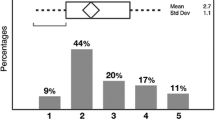Summary
Results from neuropsychological tests, collected under double-blind-precautions, were evaluated for 115 schoolage children (mean age: 9.4 years) living in a lead smelter area (Stolberg, FRG). Tooth-lead concentrations (PbT) from shed incisor teeth as measures of longtime lead-exposure were available for these children (x = 6.16 ppm; range: 1.9–38.5 ppm), and for 83 of them blood-lead concentrations (PbB) were available as well (x = 14.3 μg/dl; range: 6.8-33.8 μg/dl). The following functional capacities were tested: intelligence (German WISC), perceptual-motor integration (Göttinger Formreproduktionstest = GFT, Diagnosticum for Cerebralschüdigung = DCS), reaction performance (Wiener Determinationsgerät), finger-wrist tapping-speed, and repetitive cancellation-performance (Differentieller Leistungstest). In addition standardized behavior ratings were obtained by the examiners, the mothers, and the teachers. Multiple stepwise regression-analysis (forced solution) was calculated for outcome-variables and Pb-tooth, including age, sex, duration of labor, and socio-hereditary background as covariates. Significant (P< 0.05) or near-significant (P< 0.1) association was established between Pb-tooth and GFT-performance (errors), reaction-performance (false reactions), and four behavioral dimensions as rated by the mothers, namely distractability, restlessness, lack of information, and wasting of time; the proportion of explained variance never exceeded 6%, however, No significant association was found between PbT and WISC verbal-IQ after the effects of “socio-hereditary background” had been eliminated, although there was still a tendency for high level-children (PbT > 10 ppm) to be inferior to low level-children (PbT ≦ 4 ppm) by 4.6 IQ-points after correction for confounding. There was a near-significant, inverse relationship between fingerwrist tapping-speed and Pb-blood. The results are discussed within the framework of attention-deficit disorder, and compared to neurobehavioral Pb-effects from animal-experiments, which provide suggestive evidence for a causal relationship between developmental lead-exposure and certain neurobehavioral deficits.
Similar content being viewed by others
References
Connors CK (1969) A teacher rating scale for use in drug studies with children. Am J Psychiatry 126:884–888
David O, Clark J, Voeller K (1972) Lead and hyperactivity. Lancet II:900–903
Einbrodt HJ, Rosmanith J, Schröder A (1974) Beim Spielen durch Blei vergiftet. Umwelt 4:30–32
Einbrodt HJ, Rosmanith J (1978) Epidemiologische Untersuchungen zur Bleibelastung der Bevölkerung. Blei und Umwelt II, BGA-Bericht 1:37–46
Ernhart CB, Landa B, Schell NB (1981) Subclinical levels of lead and developemental deficit—a multivariate follow-up reassessment. Pediatrics 67:911–919
Ewers U, Brockhaus A, Winneke G, Freier I, Jermann E, Krämer U (1982) Lead in deciduous teeth of children living in a non-ferrous smelter area of West-Germany. Int Arch Occup Environ Health 50:139–151
Groppe H (1976) Experimentelle Untersuchung zur Subklassifizierung des Verhaltensmerkmals „Hyperaktivität” als Verhaltensauffälligkeit im Kindesalter. Diplom-Arbeit, Universität Düsseldorf (unpublished)
Hardesty FP, Priester HJ (1966) Hamburg-Wechsler-Intelligenztest für Kinder (HAWIK). Huber, Bern
Klebelsberg D (1960) Wiener Determinationsgerät. Diagnostica VI
Kleber EW, Kleber G (1974) Differentieller Leistungstest-KE. Hogrefe, Göttingen
Kujanek G (1981) Psychologische Untersuchung an unterschiedlich bleibelasteten Kindern. Auswirkungen auf kognitive und motorische Leistungen. Diplom-Arbeit, Universität Düsseldorf (unpublished)
Landrigan PJ, Whitworth RH, Baloh RW, Staehling NW, Barthel WF, Rosenblum BT (1975) Neuropsychological dysfunction in children with chronic low-level lead absorption. Lancet 1:708–712
Lechner H (1982) Psychologische Untersuchung an unterschiedlich bleibelasteten Kindern. Verhaltensbeurteilung durch Fremdbeobachtung in testpsychologischen, häuslichen und schulischen Situationen, sowie Auswirkungen der Bleiexposition auf den Konzentrations-Aufmerksamkeitsbereich. Diplom-Arbeit, Universität Düsseldorf (unpublished)
Milar CR, Schroeder SR, Mushak P, Dolcourt JL, Grant LD (1980) Contributions of the caregiving environment to increased lead burden of children. Am J Merit Def 84:339–344
Ministerium für Arbeit, Gesundheit und Soziales NW (1975) Umweltprobleme im Raum Stolberg. Düsseldorf
Needleman HL (1982) Personal communication
Needleman HL, Gunnoe C, Leviton A, Reed R, Peresie H, Maher C, Barrett P (1979) Deficits in psychologic and classroom performance of children with elevated dentine lead levels. N Engl J Med 300:689–695
Overman SR (1977) Behavioral effects of asymptomatic lead exposure during neonatal development in rats. Toxicol Appl Pharmacol 41:459–471
Rutter M (1982) Personal communication
Scheuch EK (1961) Sozialprestige und soziale Schichtung. In: Glass DV, König R (eds) Soziale Schichtung und soziale Mobilität. Westdeutscher Verlag, Köln, pp 65–103
Schilling F, Kiphard EJ (1974) Körperkoordinationstest für Kinder, KTK. Beltz, Weinheim
Schlange H, Stein B, Boetticher J, Taneli S (1972) Göttinger Formreproduktionstest (G-F-T). Handbuch. Hogrefe, Göttingen
Schlipköter HW, Winneke G (1980) Behavioral studies on the effects of lead in the developing central nervous system of rats. In: Commission of the European Community (ed) Environment and the quality of life. 2nd Environmental Research Programme. ECSC-EECEAEC, Brussels, Luxembourg, pp 127–134
Stoeppler M, Brandt K, Rains TC (1978) Contributions to automated trace analysis. Part II. Rapid method for the automated determination of lead in whole blood by electrothermal atomic absorption spectrophotometry. Analyst 103:714–722
Sykes DH, Douglas VJ, Morgenstern G (1973) Sustained attention in hyperactive children. J Child Psychol Psychiatry 14:213–220
Wechsler D (1949) Wechsler intelligence scale for children. Psych Corp, New York
Weidlich S (1972) DCS. Diagnosticum für Cerebralschädigung. Handbuch. Huber, Bern Stuttgart Wien
Winneke G (1982) Neurobehavioral and neuropsychological effects of lead. In: Rutter MA, Russell-Jones R (eds) Lead vs. health: Proceedings of an international symposium on “Low Level Lead Exposure and Its Effects on Human Beings.” Wiley, Chichester (in press)
Winneke G, Brockhaus A, Baltissen R (1977) Neurobehavioral and systemic effects of longterm blood-lead elevation in rats. Arch Toxicol 37:247–263
Winneke G, Hrdina KG, Brockhaus A (1982) Neuropsychological studies in children with elevated tooth-lead concentrations. Part I: Pilot study using a pair-matching approach. Int Arch Occup Environ Health 51
Winneke G, Lilienthal H, Werner W (1982a) Task-dependent neuro-behavioral effects of lead in rats. Arch Toxicol [Suppl] 5:84–93
Winneke G, Brockhaus A, Krämer U, Ewers U, Kujanek G, Lechner H, Janke W (1981) Neuropsychological comparison of children with different tooth lead levels. Preliminary Report. International Conference “Heavy Metals in the Environment,” Amsterdam 1981. CEP Consultants, Edinburgh, pp 553–556
Yule W, Lansdown R, Millar IB, Urbanowicz MA (1981) The relationship between blood lead concentration, intelligence, and attainment in a school population: a pilot study. Develop Med Child Neurol 23:567–576
Author information
Authors and Affiliations
Additional information
Preliminary results of this study were presented at the conference “Heavy Metals in the Environment,” September 15–19,1981 in Amsterdam (Winneke et al. 1981). Part of the data were used for master's theses (Kujanek 1981; Lechner 1982)
This study was carried out at the request and with support of Ministerium für Arbeit, Gesundheit und Soziales des Landes NW. Düsseldorf, FRG
Rights and permissions
About this article
Cite this article
Winneke, G., Krämer, U., Brockhaus, A. et al. Neuropsychological studies in children with elevated tooth-lead concentrations. Int. Arch Occup Environ Heath 51, 231–252 (1983). https://doi.org/10.1007/BF00377755
Received:
Accepted:
Issue Date:
DOI: https://doi.org/10.1007/BF00377755




